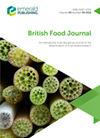Organic food-buying intention drivers: a study based on means-end chain theory
IF 3.4
3区 经济学
Q1 AGRICULTURAL ECONOMICS & POLICY
引用次数: 0
Abstract
PurposeUnderstanding how attributes, consequences and values (A-C-V) influence the predisposition to purchase and buying intention of organic food consumers (OFC) is crucial for its stakeholders. This study aims to (1) investigate whether OFC perceptions of the A-C-V impact their predisposition to purchase and buying intention; (2) examine the mediating effect of predisposition to purchase on the relationship between OFC personal values and their buying intentions and (3) verify whether consumers with distinct levels of organic food-buying intention perceive differently of the A-C-V, predisposition to purchase and consumption frequency.Design/methodology/approachThis quantitative study comprised 307 consumers who filled out a form about their perceptions of organic foods’ A-C-V and their consumption frequency, purchasing predisposition and buying intention. Partial least squares strutural equation modelling (PLS-SEM) tested the hypothetical model that resorted to the means-end chain (MEC) theory (Gutman, 1982). Cluster analysis based on OFC’s buying intentions compared their perceptions of the A-C-V, purchasing predisposition and consumption frequency.FindingsThe OFC’s perception of the attributes of these foods impacts the consequences of their consumption and values. Such values positively influence their purchase predisposition and buying intention. Predisposition to purchase measured the relationship between OFC values and purchase intention. Three OFC clusters were identified according to their buying intentions. Such groups perceive the A-C-V singularly and have different purchasing predispositions and consumption frequencies.Originality/valueOFC values directly influence buying intentions. However, the predisposition to purchase strongly mediates the relationship between values and buying intentions, producing an indirect impact more notable than a direct one. It brings academic and managerial contributions to organic food stakeholders.有机食品购买意向驱动因素:基于手段-终端链理论的研究
目的 了解属性、后果和价值观(A-C-V)如何影响有机食品消费者(OFC)的购买倾向和购买意向对其利益相关者至关重要。本研究旨在:(1)调查有机食品消费者对 A-C-V 的认知是否会影响其购买倾向和购买意向;(2)研究购买倾向对有机食品消费者个人价值观与其购买意向之间关系的中介效应;(3)验证不同有机食品购买意向水平的消费者对 A-C-V、购买倾向和消费频率的认知是否不同。设计/方法/途径这项定量研究由 307 名消费者组成,他们填写了一份关于其对有机食品的 A-C-V 感知及其消费频率、购买倾向和购买意向的表格。部分最小二乘法方程模型(PLS-SEM)检验了采用均值-末端链(MEC)理论(Gutman,1982 年)的假设模型。基于 OFC 购买意愿的聚类分析比较了他们对 A-C-V 的认知、购买倾向和消费频率。这些价值观对他们的购买倾向和购买意向有积极影响。购买倾向衡量的是海洋金融中心价值观与购买意向之间的关系。根据他们的购买意向,确定了三个 OFC 群组。这些群体对 A-C-V 的感知是单一的,具有不同的购买倾向和消费频率。然而,购买倾向在价值观和购买意向之间起着强有力的中介作用,产生的间接影响比直接影响更为显著。该研究为有机食品利益相关者带来了学术和管理方面的贡献。
本文章由计算机程序翻译,如有差异,请以英文原文为准。
求助全文
约1分钟内获得全文
求助全文
来源期刊

British Food Journal
工程技术-食品科技
CiteScore
6.90
自引率
15.20%
发文量
219
审稿时长
18-36 weeks
期刊介绍:
After 115 years, the British Food Journal (BFJ) continues to be highly respected worldwide for its broad and unique interdisciplinary coverage of the latest food-related double blind peer-reviewed research. It links all sectors of this dynamic industry, keeping abreast of emerging trends, topical and controversial issues and informing and stimulating debate. - See more at: http://emeraldgrouppublishing.com/products/journals/journals.htm?id=bfj#sthash.O3wH4pEh.dpuf
 求助内容:
求助内容: 应助结果提醒方式:
应助结果提醒方式:


